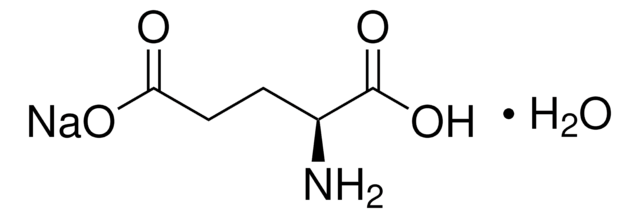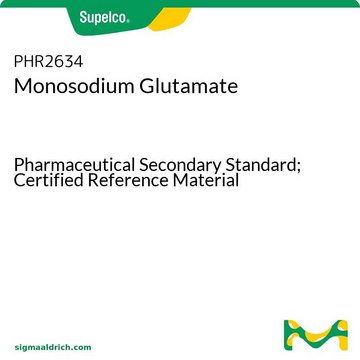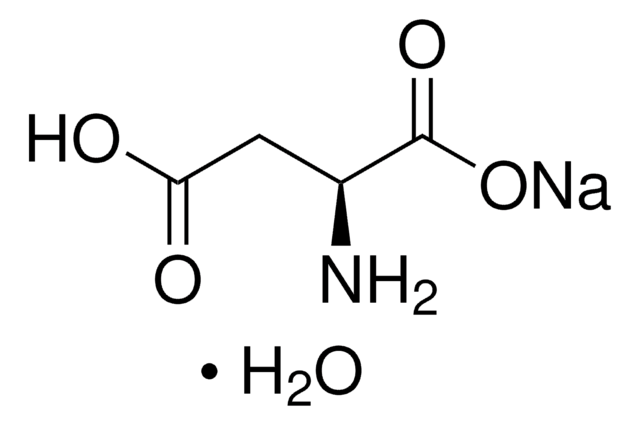G1626
L-Glutamic acid monosodium salt hydrate
≥99% (HPLC), powder
Synonym(s):
(S)-2-Aminopentanedioic acid, L-Glutamic acid monosodium salt, Glu, MSG, Monosodium glutamate
About This Item
Recommended Products
Quality Level
assay
≥99% (HPLC)
form
powder
color
white to off-white
InChI
1S/C5H9NO4.Na.H2O.H/c6-3(5(9)10)1-2-4(7)8;;;/h3H,1-2,6H2,(H,7,8)(H,9,10);;1H2;
InChI key
JYDGDQPVBSBYRT-UHFFFAOYSA-N
Gene Information
human ... GRIK1(2897) , GRIK2(2898) , GRIK3(2899) , GRIK4(2900) , GRIN1(2902) , GRIN2A(2903) , GRIN2B(2904) , GRIN2C(2905) , GRIN2D(2906) , GRIN3A(116443) , GRIN3B(116444) , GRINA(2907)
mouse ... GRIK1(14805) , GRIK2(14806) , GRIK3(14807) , GRIK4(110637) , GRIN1(14810) , GRIN2A(14811) , GRIN2B(14812) , GRIN2C(14813) , GRIN2D(14814) , GRIN3A(242443) , GRIN3B(170483) , GRINA(66168)
rat ... GRIK1(29559) , GRIK2(54257) , GRIK3(298521) , GRIK4(24406) , GRIN1(24408) , GRIN2A(24409) , GRIN2B(24410) , GRIN2C(24411) , GRIN2D(24412) , GRIN3A(191573) , GRIN3B(170796) , GRINA(266668)
Looking for similar products? Visit Product Comparison Guide
General description
Application
- as a chemical modulator to rat hippocampal slice cultures for the study of microglial movement post spreading depression (SD) prior to migraine
- as an additive to Neurobasal medium for the growth of embryonic neurons obtained from pregnant mice
- as a component of GYE (glucose yeast extract) solid medium for the growth of four strains of phytopathogen Xylella fastidiosa namely, CVC clone 9a5c, Temecula (Pierce′s disease), Jab1 (Coffee Leaf Scorch), and the isolate 6747 (Plum Leaf Scald), which causes diseases in important crop plants
- as a component of the stock solution for the equilibration of intracellular and extracellular [H+] in segmental nerves obtained from the ventral ganglion of Drosophila larvae
- as a supplement to RPMI (Roswell Park Memorial Institute) medium 1640 used to maintain K562 cell cultures with twice-weekly passage
Biochem/physiol Actions
Storage Class
11 - Combustible Solids
wgk_germany
WGK 2
flash_point_f
Not applicable
flash_point_c
Not applicable
ppe
Eyeshields, Gloves, type N95 (US)
Certificates of Analysis (COA)
Search for Certificates of Analysis (COA) by entering the products Lot/Batch Number. Lot and Batch Numbers can be found on a product’s label following the words ‘Lot’ or ‘Batch’.
Already Own This Product?
Find documentation for the products that you have recently purchased in the Document Library.
Customers Also Viewed
Our team of scientists has experience in all areas of research including Life Science, Material Science, Chemical Synthesis, Chromatography, Analytical and many others.
Contact Technical Service







